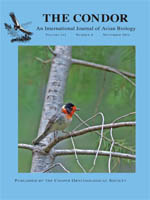In their commentary, McNair and Nisbet (2011) suggest that we (Mitchell et al. 2010) may have incorrectly rejected the migration-commencement hypothesis as a possible explanation for the broad-scale southeasterly movements made by juvenile Blackpoll Warblers (Dendroica striata) in northwestern Newfoundland during the post-fledging period. They argue that because the dominant orientation of Blackpolls departing Nova Scotia, New Brunswick, and the northeastern U.S. for transoceanic migration to the Caribbean and South America is to the south-southeast (reviewed by Nisbet et al. 1995), the pattern of movement reported in Mitchell et al. (2010) is actually consistent with the migratorycommencement hypothesis.
For our paper (Mitchell et al. 2010), we defined initial migratory movements as broad-scale movements away from the natal area, and made the a priori prediction that these movements should be parallel to the “known” axis of migration. Although we did not state so explicitly, we interpreted axis of migration as reflecting the immediate migratory trajectory of birds leaving the island of Newfoundland rather than the eventual migratory trajectory from the southwest shore of Nova Scotia or the Gulf of Maine. Our prediction that initial migratory movements should be to the southwest was based on Richardson's (1972:11) radar observations of songbirds migrating from Newfoundland to Nova Scotia (a southwest trajectory). Indeed, McNair and Nisbet (2011) agree that many juvenile Blackpolls raised in Newfoundland might initially migrate southwest to Nova Scotia before undertaking their transoceanic flight southeast to thier winter range.
We interpret the commentary by McNair and Nisbet (2011) as suggesting that juvenile Blackpolls make initial migratory movements to the southeast (toward their ultimate destination) and then either change their migratory orientation to the southwest at some later point or continue on this path to depart Newfoundland on a southeasterly trajectory. In contrast, our suggestion is that the southeasterly movements (mean orientation 135° from geographic north) we observed do not reflect movement toward an ultimate destination (a rejection of the migration-commencement hypothesis) but match other predictions we put forward (Mitchell et al. 2010). Computer simulations of the Blackpoll's migration routes by Stoddard et al. (1983) suggest that birds departing Newfoundland (∼8° longitude east of Nova Scotia) on a compass heading of 135° would end up east of South America in the Atlantic Ocean, never making landfall. Furthermore, Nisbet et al. (1963) estimated the maximum duration of flight of a Blackpoll with a full fuel load to be 105–120 hr. Stoddard et al. (1983) estimated that a bird departing southwestern Nova Scotia with an orientation of 160° should take roughly 100 hr to reach South America. If we extrapolate from the model of Stoddard et al. (1983), birds departing Newfoundland with an orientation of 160° (25° more southerly than the orientation we observed) at a speed of 45 km hr-1 should take at least 110–120 hr to reach South America, approaching the species' physiological limits. These predictions are further supported by the conclusion of Stoddard et al. (1983) that “successful migrants departing from Nova Scotia must either have headings greater than 150°, or must reorient their flight to the south en route.” Of course, in each of the above scenarios, faster flight speeds would reduce flight durations, but they also increase the likelihood of running out of fuel and not making landfall in South America (Stoddard et al. 1983). Additionally, as Stoddard et al. (1983) suggested, reorientation en route may also alter these outcomes, but in the absence of any data on those possibilities, we could only speculate as to the potential influence of such changes. Therefore, given the location of Newfoundland relative to the Blackpoll's winter range, post-fledging movement to the southeast most probably does not reflect movement toward an ultimate destination and is therefore not consistent with initial migratory movements.
We thank McNair and Nisbet (2011) for bringing forward an alternative interpretation of our data; their comment highlights an important gap in the general understanding of the migratory ecology of boreal passerines in northeastern North America. Further research is needed to document the migratory trajectories of the Blackpoll Warbler and all other migratory passerines departing Newfoundland. Specifically, additional radar work along the southern coast of Newfoundland supplemented with orientationcage experiments (e.g., Fitzgerald and Taylor 2008) would provide a clearer picture of the orientation of birds leaving Newfoundland.





